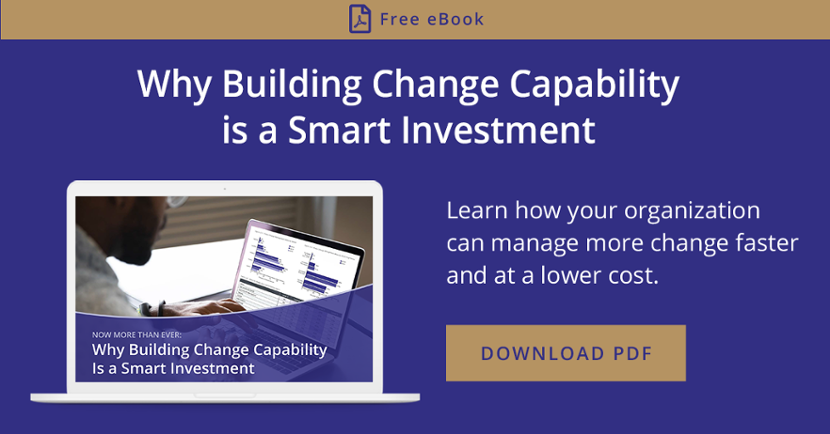

2. Failed changes
Each of us can list a number of poorly implemented changes in our organizations. Some changes end up behind schedule. Others run over budget. Some face tremendous resistance when employees experience barriers to adoption. Some changes get implemented, but the expected results never materialize. In some cases, changes fail completely and are abandoned. Many of the reasons past projects didn't achieve intended outcomes are tied to mismanaging the people side of change.
Now consider the cost of these failed changes. How much time and money was spent on initiatives that were not fully implemented? What was the impact to the organization from not implementing these changes ? Your organization cannot risk the additional cost and missed benefits of poorly managing the human side of change.
Building the organization-wide competency to manage change effectively can be a cost-avoidance measure that minimizes impacts from failed changes.
3. Upcoming changes
In addition to minimizing the risk of failed change, the number and types of changes on the horizon further support the rationale for building the organizational competency to manage change. The years ahead promise bigger, more critical, more complex changes at an accelerating pace.
Organizations are constantly working to implement new technologies, upgrade systems, improve productivity, cut costs, and manage human capital in the organization. Initiatives like digital transformations and culture changes include an entire portfolio of complex projects being executed across the organization.
At any one time, your organization may have 50 to 100 projects underway impacting how individuals do their jobs—with 50 to 100 more on the schedule. Improving how your organization manages change will directly affect the success of each of initiative today and in the future. And the high-priority, more strategic initiatives typically have a direct impact on how employees do their jobs, increasing the need for change management. With so much change on deck, effective change management will be critical to project outcomes and the organization's ability to meet objectives.
4. Consistent application
Although there certainly is value to applying change management to a single project, the value is magnified when organizations begin consistently applying change management on each and every change. This is a key component of organizational change management competency. Adopting and deploying a common approach results in more consistent application both by individual practitioners and across numerous projects. This step of adopting a common approach includes common processes, tools, practices and language throughout all levels and all projects.
There are numerous benefits to applying change management more consistently. First, a common set of resources and subject matter experts can support a variety of change management practitioners. When you apply a common approach consistently, learning curves shorten. A common approach also provides a platform for continuous learning and improvement. Each time change management is applied, practitioners can generate lessons learned that will improve subsequent change management efforts. Without this consistent application, continuous improvement of the change management process and approach cannot occur.
Not adopting a common approach to change also carries risk. Think about a single manager being asked to fulfill three completely different roles by three change management practitioners who are supporting three different changes. While each of the practitioners works to optimize adoption of their particular change, the manager can become confused and disengage from all change management activities. The same backfire effect can occur with senior business leaders, project teams and other project support functions (such as communication specialists or training specialists).
One of the first steps in building enterprise change management competency is selecting and deploying a common approach, which improves change management efforts throughout the organization.

5. Personal competency
Finally, it's important to consider the individual perspective related to building organizational change management competency. Aside from the organizational reasons above, managing change is an emerging and important individual skill set that leaders and people managers throughout the organization need to add to their portfolio.
Several key best practices show why managing change is necessary as a personal competency at many levels in the organization. Prosci's biennial Best Practices in Change Management research studies consistently identify the role of the primary sponsor as the number one contributor to successful changes. The sponsor's role includes actively and visibly participating with the project team, building a coalition of sponsorship with peers and other managers, and communicating directly with employees about the need for change. However, fulfilling these roles does not come naturally for many senior leaders. Even the best leaders in an organization may need support, training and coaching on how to be an effective sponsor. The same holds true for people managers when it comes time to fulfill the role of coach, communicator and resistance manager when changes are introduced.
Project team members can also build personal competencies related to managing change. Even the Project Management Institute has started to add managing the human component of change to the body of project management skills.
A final element of organizational change competency is the collective individual competencies built throughout the organization, from the person sitting at the very top all the way down to front-line employees. Change management competency shows up across the entire organization, and must be managed both from the organizational and the personal perspective.
Enterprise Change Management Is the Future
In organizations across the globe, there is in an increased need to truly build the competency to manage change. Building the competency sets your organization apart and improves the execution of each new project implemented. It allows you to minimize the substantial negative consequences of mismanaging change and better position yourself for success on future initiatives. Building the competency to change is not easy—it requires design, project management, change management and commitment from the organization. But it will be critical for success in coming years.





